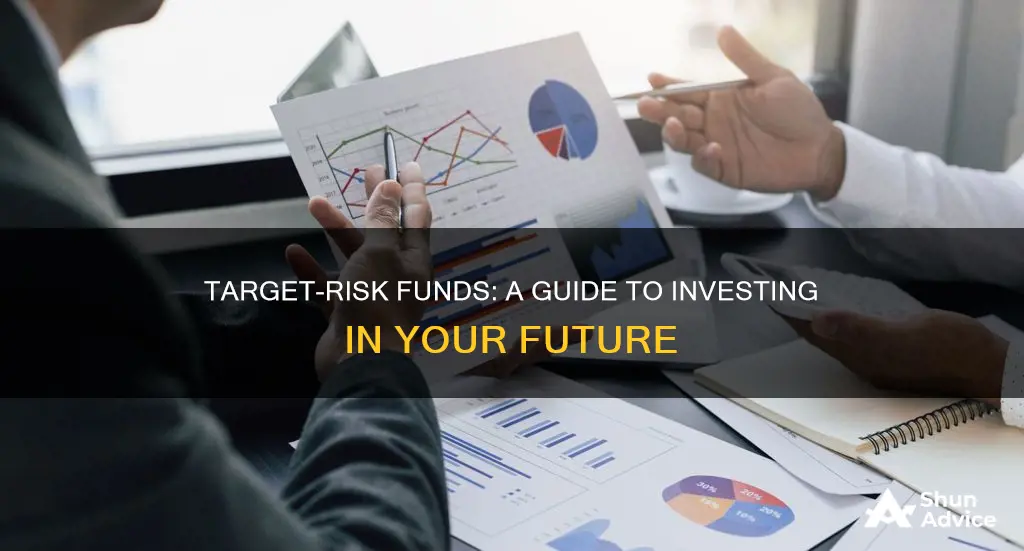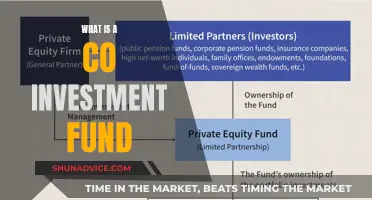
Target-risk funds, also known as asset allocation funds, are investment funds that offer a diversified mix of stocks, bonds, and other assets to match an investor's risk tolerance. These funds are designed to maintain a relatively constant level of risk over time, with the fund manager ensuring the level of risk aligns with the desired risk profile. Target-risk funds are often labelled from conservative to aggressive, allowing investors to choose a fund that suits their risk appetite. Unlike target-date funds, which adjust their asset allocation over time, target-risk funds offer a more hands-on approach, requiring investors to actively choose a fund that matches their desired level of risk. By investing in target-risk funds, individuals can benefit from a simplified investment strategy, a diversified portfolio, and the expertise of professional fund managers.
What You'll Learn

Understanding your risk tolerance and financial goals
When considering target-risk funds, it is essential to assess your comfort with risk. These funds typically offer choices ranging from conservative to aggressive strategies. A conservative approach seeks to protect your investments and accepts lower returns, while an aggressive strategy aims for higher growth potential by allocating more funds to stocks and accepting greater downside risk. Your risk tolerance may change over time, especially as you get closer to retirement, so it is important to review and adjust your investments periodically.
To determine your risk tolerance, ask yourself the following questions:
- What are your investment goals? Understanding your goals is the first step in deciding how much risk you are willing to take. Common goals include saving for retirement, education expenses, or financial independence.
- What is your time horizon? The time horizon refers to when you plan to use the invested money. Generally, a longer time horizon allows for taking on more risk, as there is a higher chance of recovering from potential downturns.
- How comfortable are you with short-term losses? Investments can fluctuate, and it's important to consider how you would handle temporary declines in value. If you may need your money in the near term, you should be more cautious, as you might be forced to sell at a loss.
- Do you have non-invested savings? It is important to have savings set aside in liquid accounts for emergencies, and keeping a large portion of your savings in cash may indicate risk aversion.
- How often will you track your investments? If you plan to track your investments frequently, consider whether it is due to excitement or anxiety. A diversified portfolio and long-term focus can help make market fluctuations more manageable.
By answering these questions, you can gain a better understanding of your risk tolerance and financial goals, which will guide your decision-making when investing in target-risk funds.
Merrill Mutual Funds: Choosing the Right Investment for You
You may want to see also

The pros and cons of target-risk funds
Target-risk funds are a type of investment fund that holds a diversified mix of stocks, bonds, and other assets to create a specific risk profile. The fund manager ensures that the level of risk is aligned with the fund's target risk exposure and remains relatively constant over time. These funds are labelled to indicate their risk level, ranging from "conservative" to "aggressive".
Pros:
- Diversification: Target-risk funds offer investors a well-diversified portfolio of stocks, bonds, and other investments in a single fund. This provides a simple way to gain exposure to different asset classes and reduce the risk of concentrating investments in one area.
- Risk Management: These funds allow investors to choose their desired level of risk, whether conservative, moderate, or aggressive. The fund manager actively oversees the fund to ensure it maintains the targeted risk level, providing a value-added service for investors who want to manage their risk exposure.
- Flexibility: While target-risk funds maintain their risk level, investors can adjust their risk exposure over time by switching between funds. This flexibility allows investors to adapt their investment strategy as their circumstances change or as they approach retirement.
Cons:
- Fees: Target-risk funds often have fees associated with their management, which are charged on top of the fees for the mutual funds within the target-risk fund. These fees can impact overall investment returns, especially if the fund underperforms.
- Performance: The performance of target-risk funds depends on the fund manager's ability to maintain the desired risk level and generate returns. Poor performance or underperformance relative to other investment options may impact the attractiveness of these funds.
- Limited Customisation: While target-risk funds offer a range of risk levels, they may not cater to specific investor needs or goals. Some investors may prefer to create their own portfolio or work with a financial advisor to develop a more tailored investment strategy.
Overall, target-risk funds offer a convenient way to invest based on an individual's risk tolerance, providing a diversified portfolio with active risk management. However, investors should carefully consider the potential drawbacks, including fees, performance, and the lack of customisation.
Equity and Debt Funds: Diversifying Your Investment Portfolio
You may want to see also

How target-risk funds differ from target-date funds
Target-risk funds and target-date funds are both investment options for people saving for retirement. However, they differ in several ways.
Firstly, target-date funds are designed to reduce risk over time, whereas target-risk funds typically maintain their risk level indefinitely. Target-date funds are usually named by the year in which the investor plans to retire and become more conservative as the target date approaches. In contrast, target-risk funds are labelled according to the level of risk they carry, such as "conservative" or "aggressive", and this level of risk does not change over time.
Secondly, target-date funds are often a "set it and forget it" option, with the fund's portfolio managers automatically adjusting the asset allocation to meet the investor's objective. On the other hand, target-risk funds require the investor to be more involved. While the fund manager ensures that the fund's level of risk remains on target, the investor may decide to switch to a more conservative or aggressive fund as their personal circumstances change.
Thirdly, target-date funds are usually designed to be an investor's only investment in a 401(k) plan. In contrast, target-risk funds are intended to make managing your investments easier by offering a one-fund option within a group retirement program that includes other investment options.
Finally, target-date funds are very popular, with 64% of retirement contributions invested in them in 2023, according to Vanguard. This may be because they are a default option in many employer-sponsored 401(k) plans, and they offer an easy, low-fee, and diversified option for retirement savings. In contrast, there is no mention of the popularity of target-risk funds in the sources provided, suggesting that they may be less popular than target-date funds.
Investing in Funds: Smart Money Management for Long-Term Growth
You may want to see also

How to choose the right target-risk fund for you
Target-risk funds are mutual funds designed to maintain a constant level of investment risk over time. They are also known as asset allocation funds or all-in-one funds. These funds allow investors to choose a risk profile that suits them, ranging from conservative to aggressive.
Your Risk Tolerance
The primary factor in choosing a target-risk fund is your comfort with risk. Target-risk funds are designed to align with your risk tolerance, so you need to decide how much risk you are willing to take. Some funds offer a conservative approach with lower risk and relatively lower returns, while others are more aggressive, seeking higher growth through a larger allocation of stocks.
Your Investment Goals
Consider your financial goals and what you want to achieve through these investments. Are you seeking modest growth, or do you want higher levels of growth? Your investment goals will help determine the level of risk you are comfortable with and the type of target-risk fund that aligns with those goals.
Your Time Horizon
Your age, life stage, and how close you are to retirement are crucial factors. Younger investors often opt for more aggressive funds with higher risk and growth potential, while older investors tend to move towards more conservative funds to protect their assets as retirement nears.
Your Investor Strategy
Are you seeking a hands-off approach, or do you want to be more involved in managing your investments? Target-risk funds are designed to simplify investment management, but they may require adjustments over time as your personal circumstances change. You may need to switch to a more conservative or aggressive fund as you get closer to retirement or as your risk tolerance changes.
Fund Characteristics
Each target-risk fund has unique characteristics, including its investment objective, management style, risks, and investment minimums. Be sure to review the fund prospectus to understand these details before making a decision. Additionally, consider the fees associated with the fund and how they may impact your returns.
Remember, choosing the right target-risk fund is a personal decision based on your financial situation, goals, and risk tolerance. You can always consult a financial advisor to help you assess your options and make a choice that aligns with your investment strategy.
Fidelity Mutual Funds: Investing in Corporate Debt
You may want to see also

The role of a fund manager in a target-risk fund
A target-risk fund is a type of investment fund that holds a diversified mix of stocks, bonds, and other assets to create a desired risk profile. The fund manager plays a crucial role in ensuring that the fund maintains its target risk exposure. Here is an overview of the role of a fund manager in a target-risk fund:
Determining Risk Exposure
The fund manager of a target-risk fund is responsible for overseeing the securities within the fund. The primary objective is to ensure that the level of risk aligns with the fund's target-risk profile. This involves monitoring the mix of investments to maintain the desired balance between risk and potential return.
Adjusting Asset Allocation
While target-risk funds typically maintain a constant level of risk exposure, the fund manager can make adjustments to the asset allocation over time. This is known as the "glide path," where the target risk exposure may change as investors move through different life stages. For example, younger investors often target more risk, while older investors closer to retirement may seek to reduce their risk exposure.
Conducting Research and Analysis
Fund managers are responsible for conducting thorough research and analysis to make informed investment decisions. This includes studying the financial industry, monitoring market trends, and evaluating companies to identify investment opportunities that align with the fund's risk profile.
Managing Trading Activities
Fund managers manage the fund's trading activities, including buying and selling securities such as stocks, bonds, and other investments. They work closely with a team of analysts and traders to execute these activities and ensure they align with the fund's investment strategy.
Reporting and Client Communication
Fund managers also play a crucial role in reporting the fund's performance to existing and potential clients. They prepare reports that outline the fund's returns, risks, and objectives. Additionally, they may identify and communicate with potential new clients who align with the fund's investment strategy and risk profile.
Compliance and Regulation
Fund managers must also ensure that the fund operates within regulatory requirements and industry standards. This includes adhering to investment guidelines, disclosure requirements, and ethical practices to protect the interests of investors.
In summary, the fund manager of a target-risk fund plays a vital role in overseeing the fund's investment strategy, managing risk exposure, conducting research, and ensuring compliance. Their expertise and decision-making contribute to the fund's performance and help maintain the desired level of risk for investors.
Pension Funds: Exploring Their Diverse Investment Strategies
You may want to see also
Frequently asked questions
Target-risk funds, also known as asset allocation funds, are ready-made funds that align with your risk tolerance. They are designed to maintain a relatively constant level of investment risk over time.
Target-risk funds offer a diversified mix of stocks, bonds, and other investments to create a desired risk profile. The fund manager is responsible for ensuring the fund's level of risk exposure aligns with its target-risk exposure.
Target-risk funds allow investors to adjust their level of risk exposure throughout their lives. They also offer a simple, one-fund option for those who want to manage their investments more easily.
Knowing your financial goals and comfort with risk will help you pick the best target-risk fund for you. You decide the amount of risk and potential return you’re comfortable with, then choose a fund based on its risk strategy.
You can invest in target-risk funds through a financial advisor or directly with a fund company or brokerage account. It's important to review the fund's prospectus to understand its unique investment objective, management style, risks, and investment minimums.







